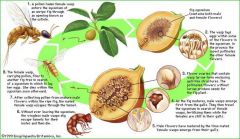![]()
![]()
![]()
Use LEFT and RIGHT arrow keys to navigate between flashcards;
Use UP and DOWN arrow keys to flip the card;
H to show hint;
A reads text to speech;
29 Cards in this Set
- Front
- Back
|
Compare external structure of honey bees to other common insects eg. grasshopper. How are they similar/different? |
Similarities: 3 body parts, 2 pairs of wings (except in Diptera) six pairs of legs, legs have same basic structure, head similar in shape. |
|
|
What are the physical characteristics and developmental stages shared by all holometabolous orders that make them different from other insects? Name and describe as many of these differences as you can -- both, for adults and for immatures.
|
Holometabolous: Complete metamorphosis |
|
|
Discuss and contrast insect defence by mimicry and insect defence by hiding
|
Defence by Mimicry: Defend themselves by looking like other animals. A good example is the Viceroy butterfly and the Monarch butterfly. The Monarch is poisonous, the Viceroy likes to pretend it is. |
|
|
Identify and discuss some of the similarities between ants and termites
|
Similarities:Trophallaxis for social regulation, Pheromones to control caste development and behaviour, Similar nest structure and complexity. |
|
|
Identify and discuss some of the differences between ants and termites |
Ants: Cast determination = nutrition |
|
|
Discuss and describe Subsociality and Eusociality in social insects
|
Sociality in insects comes in two forms; Subsociality: Insects with less strongly developed social habits such as provisioning for young, and, Eusociality: Or ‘True Sociality’ where insects co-operate to form highly complex, caste driven nest systems. |
|
|
It is thought that insects co-evolved with plants. Give an example of mutualism and pollination and describe why this is important
|

Pollination and mutualism are not mutually exclusive, however there is one insect life cycle that represents both. The Fig wasp life cycle allows the fig flower to be pollinated, and the wasp to reproduce at the same time. Both rely solely on the other for reproduction. The process occurs as follows:
|
|
|
Name important hormones in insect development |
Ecdysteroid – promotes molting
|
|
|
What are galls and what forms do they come in? |
Galls are growths on a plant usually activated through insect intervention. Filz galls - hairy outgrowths on surface, insect within |
|
|
Describes types of phytophagous herbivory |
Leaf eaters - chewers, miners |
|
|
Whats the difference between direct flight and indirect flight |
Direct flight- wings pivot up and down around single pivot point. Muscles connected directly to wing contract to bring it up and down.
|
|
|
How can the diet of an insect be determined? |
-Direct observation
|
|
|
Name some ways plants have adapted to deter heriborous insects |
Mechanical
|
|
|
Why are Coleoptera (beetles) the most successful animals? |
Elytra - hindwings fold under elytra and covers spiracles, reducing water loss. Also very compact as they house the coxa in a cavity. Allows them to cocupy all sorts of habitats |
|
|
What is myiasis? |
Infestation of living vertebrate tissue with the maggots of a fly which eats otherwise healthy tissue. |
|
|
What three traits define eusociality? |
1. Division of labour with a caste system involving sterile or non-reproductive individuals assisting those which reproduce
|
|
|
How do parasites overcome their hosts immune response? |
- Avoidance of haemolymph response
|
|
|
Explain the different types of host use by parasitoids |
Polyembrony – single egg divides multiple times to produce up to 3000 offspring
|
|
|
Difference between Idiobiont and Konobiont parasitoids? |
Idiobiont – kills or paralyses host so it does not develop further. Larvae typically undergo rapid development (finite resources) almost invariably ectoparasitoids.
|
|
|
Define aposematism and deimatic colouring and the differences between them. |
Aposematism - Warning colouring, used by insects to deter predators by warning that they are poisonous or toxic. |
|
|
What important roles do detritivores & scavengers play? |
Soil ecosystems: Responsible for structuring & turning over soil
|
|
|
Difference between Batesian mimicry and Mullerian mimicry? |
Batesian mimicry – mimicking the warning signals of a harmful species to a common predator. Eg. Monarch poisonous, Viceroy nearly identical but palatable.
|
|
|
Similarity through a. convergent evolution or b. common ancestry |
a) homoplasy |
|
|
Why might we collect insects? |
1. to determine species present |
|
|
5 insects with the most number of described species? |
Coleoptera (350,000)
|
|
|
Difference between entognatha and ectognatha? |
Entognatha - ametabolous, wingless, jaws retracted in head. Collembola, diplura, protura. |
|
|
What adaptations have cave-dwelling insects developed? |
Vestigial / absent eyes, reduced pigmentation, small body, elongated legs, loss of wings. |
|
|
What behaviours do insects use to attract mates? |
Courtship – Bringing Sexes together
|
|
|
Discuss fleas as a vector for disease. |
Fleas are one of many vectors for disease. Parasitic fleas may specialize on specific mammals, but can usually use other mammals as hosts, leaving humans susceptible to parasitism. Viruses and bacterial pathogens can both be spread, including flea-borne typhus, bartonella and the bubonic plague. The bubonic plague ravaged empires throughout history when fleas fed on the blood of infected rats, contracting y.pestis. When their rat hosts die, they seek out other hosts, where y. pestis could propagate in the gut and spread. |

